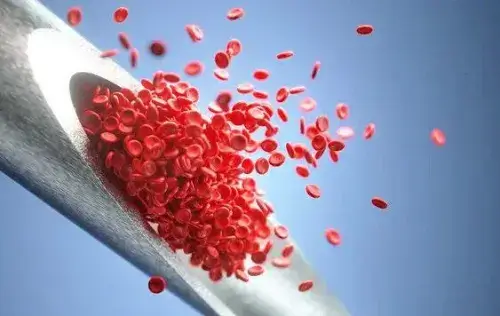Blood Clots. Potential threats, Our bodies are incredibly complex systems that work tirelessly to keep us alive and healthy. One of the most vital of these processes is blood coagulation, or clotting.
It’s a natural and essential mechanism that protects us from excessive bleeding in the event of an injury. However, sometimes this lifesaver can turn into an enemy, forming dangerous blood clots that can pose a serious threat to our health and even our lives.
In this article, we’ll take a deep dive into the fascinating and sometimes frightening world of blood clots.
We’ll explore what they are, the different types, their symptoms, risk factors, and, most importantly, what we can do to protect ourselves. Our goal is to provide a comprehensive and engaging overview that empowers you with the knowledge to stay safe and healthy.
Blood Clots, Bodyguard and Potential Threat.
What Exactly Is a Blood?
In simple terms, a blood clot (or thrombus) is a clump of blood that has transformed from a liquid to a gel-like or semi-solid state. This process is a genetically programmed survival mechanism.
When you get a cut or an injury, your body’s defense system springs into action. Platelets, which are tiny blood cells, and a network of proteins called clotting factors work together to form a clot at the site of the injury.
This process is a marvel of biological engineering, acting like a natural plug to stop the bleeding and allow the wound to heal.
Imagine you accidentally cut your finger. Initially, blood flows freely, but after a few moments, the bleeding stops. This is the direct result of a clot forming. Without this ability, even a minor cut could be fatal.
When Can a Clot Become Dangerous?
While blood clot formation is a natural and necessary process, sometimes these clots can become a serious health threat. A problem arises when a clot forms inside a vein or artery and doesn’t dissolve on its own.
As long as the clot remains stationary and attached to the vessel wall, it typically doesn’t pose an immediate threat. However, there’s a significant risk that the clot could break away and begin traveling through the bloodstream.
If a dislodged clot (called an embolus) travels to the heart or lungs, it can get stuck and block blood flow, leading to a life-threatening situation. If you suspect you have a blood clot, it’s crucial to seek immediate medical attention.
A healthcare professional can evaluate your symptoms and medical history to recommend the necessary steps.
Types of Blood Clots.
Veins vs. Arteries.
Our circulatory system is made up of veins and arteries, which work together to transport blood throughout the body. Blood clots can form in either, and their effects can differ significantly:
• Arterial Clots: An arterial clot typically causes immediate and severe symptoms, such as intense pain or the paralysis of a body part. These clots require emergency medical care because they can lead to a heart attack or stroke. They often form when plaque buildup (atherosclerosis) in the arteries ruptures, creating a clot that blocks blood flow.
• Venous Clots: Venous clots can develop more slowly, but they can still be life-threatening. The most serious type of venous clot is a deep vein thrombosis (DVT).
Deep Vein Thrombosis (DVT).
Deep vein thrombosis is a condition where a blood clot forms in one of the major veins deep inside the body. Most often, DVT affects the lower extremities (legs), but it can also occur in the arms, pelvis,
lungs (in which case it is called a pulmonary embolism), or even the brain. While a doctor’s consultation is necessary to confirm a DVT, being aware of the most common symptoms and risk factors can help you seek help promptly.
Symptoms of a Blood Clot.
What to Look For.
A blood clot can form with no obvious symptoms, or its signs may overlap with other health issues. However, it’s vital to recognize the initial signs and symptoms of a clot in different parts of the body:
In a Leg or Arm.
Blood clots most often form in the lower leg. The symptoms can vary and depend on the size of the clot. They can include:
• Swelling: Swelling in the affected limb, which can be minor or pronounced, covering the entire leg or arm.
• Pain: Pain that can range from mild to severe and usually intensifies with movement.
• Warmth: The affected area may feel warm or even hot to the touch.
• Redness: The skin over the clot may become reddish or bluish.
• Weakness or Cramping: You might experience weakness or cramps in the affected limb.
• Important Note: Blood clots in both legs or arms are rare. If symptoms only affect one limb, the likelihood of a clot increases.
In the Heart (Heart Attack).
A blood clot in the heart causes a heart attack, which is a medical emergency. Symptoms can include:
• Chest Pain or Pressure: Pain may radiate to the left arm, neck, jaw, or back.
• Shortness of Breath: A sudden and unexplained shortness of breath.
• Dizziness or Fainting: Due to impaired blood circulation, you might feel dizzy or even faint.
• Sweating and Nausea: Excessive sweating and nausea may also occur.
In the Abdomen.
Severe abdominal pain and swelling can indicate a blood clot in the abdomen. These symptoms can be similar to those of food poisoning or other digestive problems.
In the Brain (Stroke).
A stroke is caused by a blood clot that blocks blood flow to the brain. The symptoms appear suddenly and are very serious:
• Sudden and Severe Headache: Often described as “the worst headache of your life.”
• Difficulty with Speech or Vision: Sudden trouble speaking, understanding speech, or impaired vision in one or both eyes.
• Weakness or Numbness in the Face, Arm, or Leg: This usually affects one side of the body.
• Loss of Balance or Coordination: Sudden difficulty walking or maintaining balance.
In the Lungs (Pulmonary Embolism – PE).
A PE occurs when a blood clot (usually from a DVT in the leg) travels to the lungs. A PE is a life-threatening condition, and its symptoms include:
• Sudden Shortness of Breath: Shortness of breath not caused by physical exertion.
• Chest Pain: Pain may worsen when you breathe in.
• Coughing: A dry cough may occur, sometimes with blood.
• Accelerated Heartbeat: Your heart rate may become rapid and irregular.
• Dizziness or Fainting: Due to impaired blood circulation, you might feel dizzy or faint.
Risk Factors for Blood Clots.
Certain factors significantly increase the likelihood of blood clots. It’s essential to be aware of them to take preventative measures:
• Recent Hospitalization: Long-term hospital stays or major surgery significantly increase the risk of blood clot formation.
• Age: The risk increases with age, especially for individuals over 65.
• Long Journeys: Long flights or car rides of more than four hours spent in a seated position increase the risk.
• Bed Rest or a Sedentary Lifestyle: Prolonged immobilization, such as after an injury or illness, reduces blood flow and promotes clot formation.
• Obesity: Excess weight increases the strain on blood vessels and promotes inflammation.
• Family History of Blood Clots: If you have a family history of blood clots, your risk is elevated.
• Smoking: Smoking damages blood vessel walls and thickens the blood, contributing to clot formation.
• Cancer and its Treatment: Certain types of cancer and their treatments (e.g., chemotherapy) increase the risk of clots.
• Hormone Therapy: Birth control pills or hormone replacement therapy can increase the risk, especially in women who smoke.
• Pregnancy and Postpartum Period: During pregnancy and in the first six weeks after childbirth, a woman’s body is at a heightened risk for clots.
• Dehydration: Insufficient fluid intake can thicken the blood and promote clot formation.
When to See a Doctor.
Blood clots can be challenging to diagnose based on symptoms alone, as approximately 50% of people with a clot experience no symptoms. That’s why it’s always best to contact your doctor immediately if you have any suspicions.
Symptoms that appear suddenly and without an apparent cause are particularly concerning. Call your doctor or emergency services immediately if you experience any of the following:
• Sudden and unexplained shortness of breath.
• A feeling of pressure or severe chest pain.
• Difficulty breathing.
• Sudden vision problems or difficulty speaking.
• Sudden weakness or numbness on one side of the body.
• Severe pain and swelling in one leg or arm that does not go away.
How to Prevent Blood Clots.
For people at an increased risk of blood clots or with a history of thrombosis, it’s crucial to take proactive measures to prevent their formation:
• Physical Activity: Regular physical activity is one of the most effective ways to keep your circulatory system healthy and reduce the risk of clots. Exercise, walking, running, swimming, and other physical activities improve blood flow and prevent the blood from becoming too thick. Try to be active for at least 30 minutes on most days of the week. If you have a sedentary job, get up and stretch regularly.
• Diet and Hydration: A healthy and balanced diet is essential for blood vessel health. Include plenty of vegetables, fruits, healthy fats (e.g., avocados, nuts, olive oil), and fiber in your diet. Limit foods that can increase blood clotting, such as those rich in salt, saturated fats, and trans fats. It’s especially important to drink enough water to stay hydrated and prevent the blood from thickening.
• Weight Management: Maintaining a healthy weight is critical to reducing the risk of blood clots. Obesity increases the strain on the heart and blood vessels.
• Quit Smoking: Smoking is one of the leading risk factors for clots. Quitting is one of the best ways to improve blood vessel health and reduce your risk.
• Alcohol Consumption: Moderate alcohol consumption, if any, is recommended. Excessive alcohol use can affect blood clotting.
• Medication: For individuals at high risk of thrombosis or with a history of it, a doctor may prescribe medications that reduce blood clotting, such as anticoagulants (“blood thinners”). These medications should be used strictly according to a doctor’s instructions and with regular monitoring. Never take these medications without a prescription.
• Thyroid Treatment: Individuals with an increased risk of thrombosis may need thyroid disease treatment, as thyroid dysfunction can affect blood clotting.
• Regular Medical Check-ups: Regular visits to your doctor are important to monitor your health and identify potential risks for clot formation in a timely manner. Your doctor can determine appropriate preventive measures and treatment options to reduce your risk and monitor your health.
In Conclusion.
The formation, prevention, and treatment of blood clots are highly individual processes that depend on each person’s health status and risk factors. Therefore, it is crucial to consult a doctor to determine the most suitable course of action for your specific situation.
Your doctor can assess whether there’s cause for concern, recommend additional tests, and create an effective treatment plan. Taking care of your health is in your hands.





